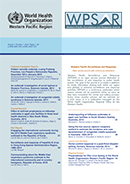Hidden varicella outbreak, Luang Prabang Province, the Lao People’s Democratic Republic, December 2014 to January 2015
DOI:
https://doi.org/10.5365/wpsar.2015.6.2.010Abstract
Background: In January 2015, the Lao People's Democratic Republic Ministry of Health received a report of 34 cases of fever and rash with one laboratory-confirmed measles case in Houitone village, Pakseng District of Luang Prabang Province. Between 21 and 27 January, we conducted a field investigation to determine the etiology, magnitude and severity of this outbreak.
Methods: We conducted active case findings in Houitone and neighbouring villages and collected information on age, location, date of rash onset, symptoms and measles vaccination status. We collected serum samples from cases with rash onset of less than 28 days and tested for measles and rubella IgM using enzyme-linked immunosorbent assay.
Results: Between 22 December 2014 and 23 January 2015, 190 fever and rash cases were identified in seven villages in Pakseng District with the majority of the cases in Houitone village. The most affected age group was between 1 and 9 years. The majority of the rashes were vesicular. Of the additional 43 serum samples collected, no samples tested positive for measles or rubella IgM. The clinical manifestation and epidemiology of the disease suggested a varicella outbreak.
Conclusion: The rapid response to a single laboratory-confirmed measles case did not identify a measles outbreak but suggested a varicella outbreak. Low measles vaccination coverage led us to recommend a routine catch-up vaccination campaign. We also recommend collecting information of rash types and photos of rashes in future fever and rash outbreaks to better differentiate potential etiologies.

